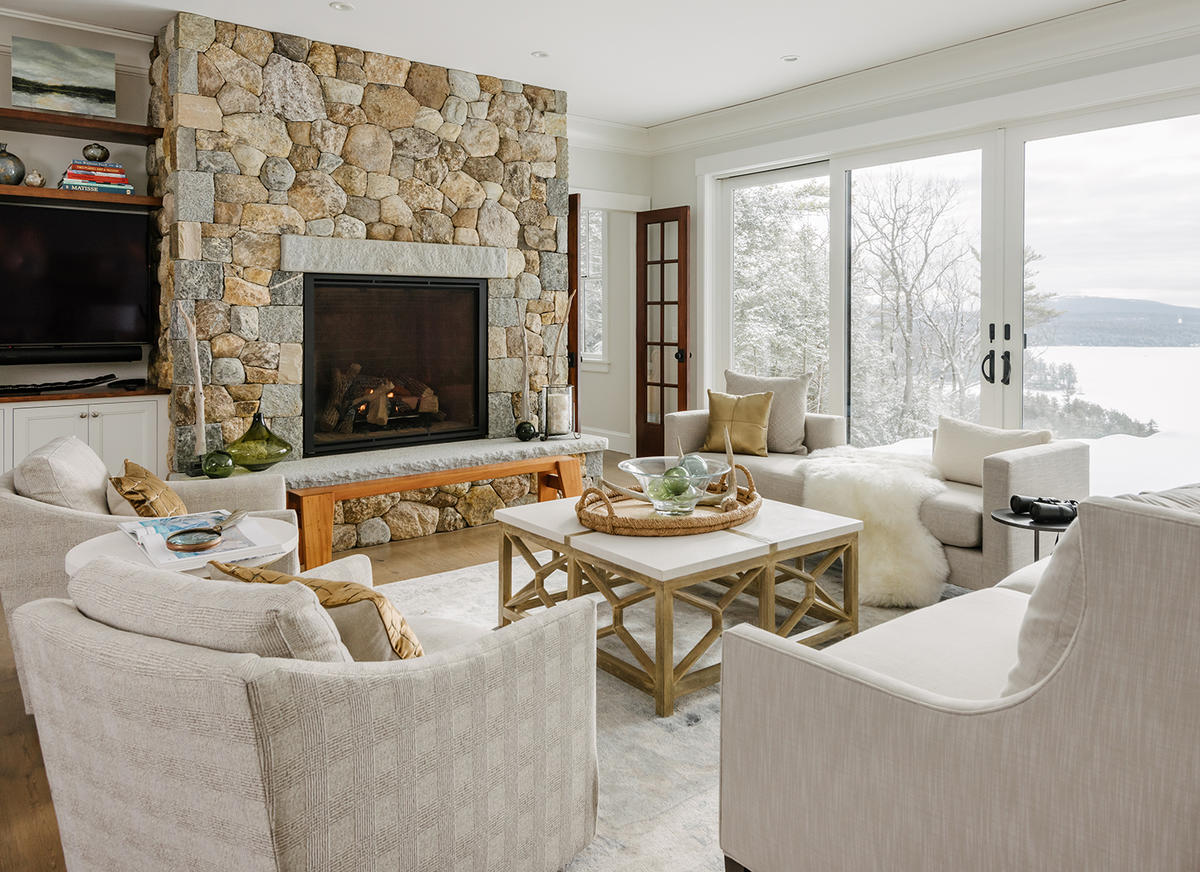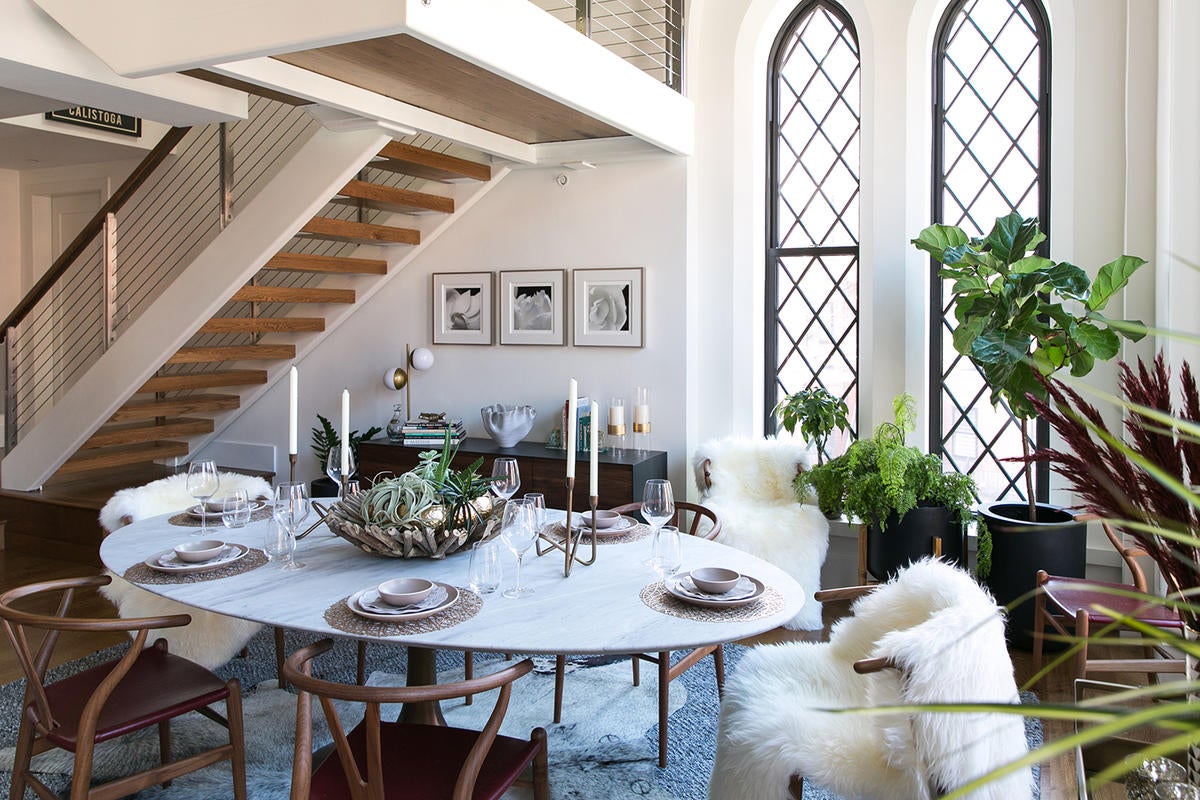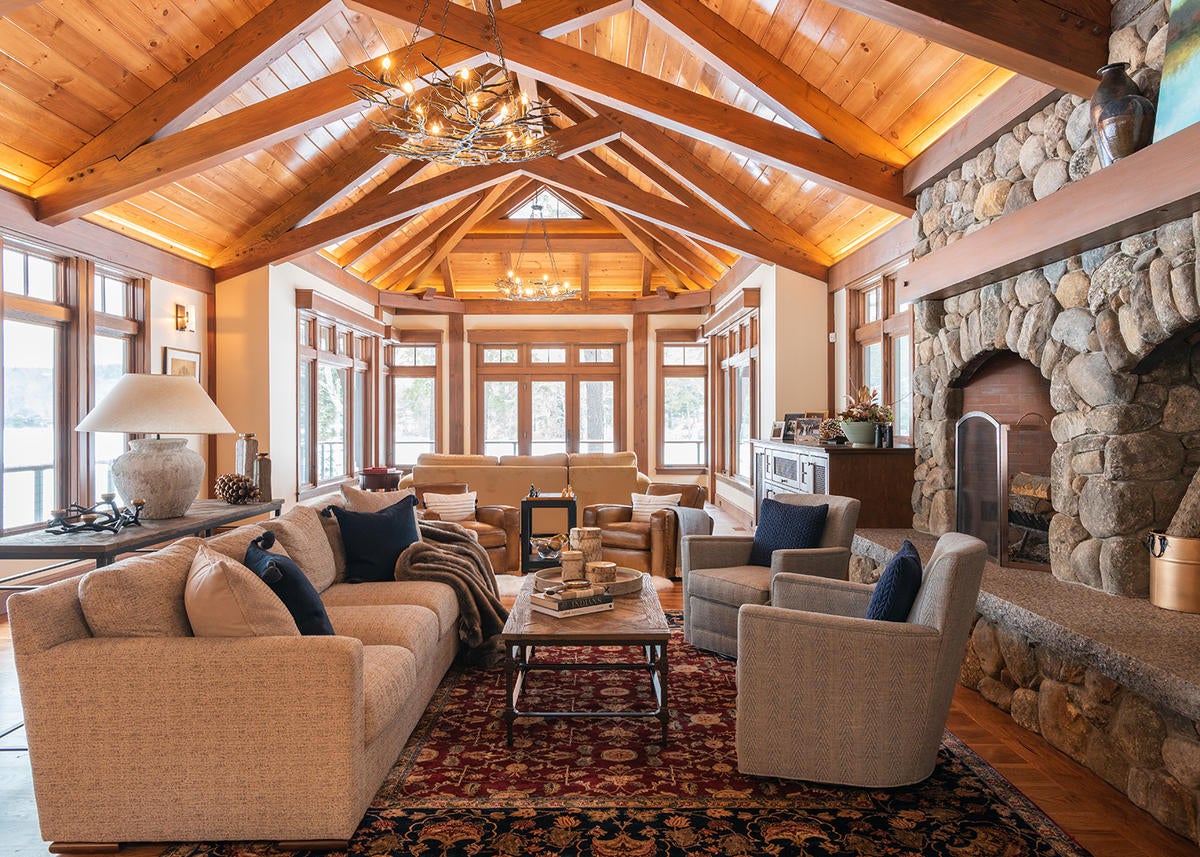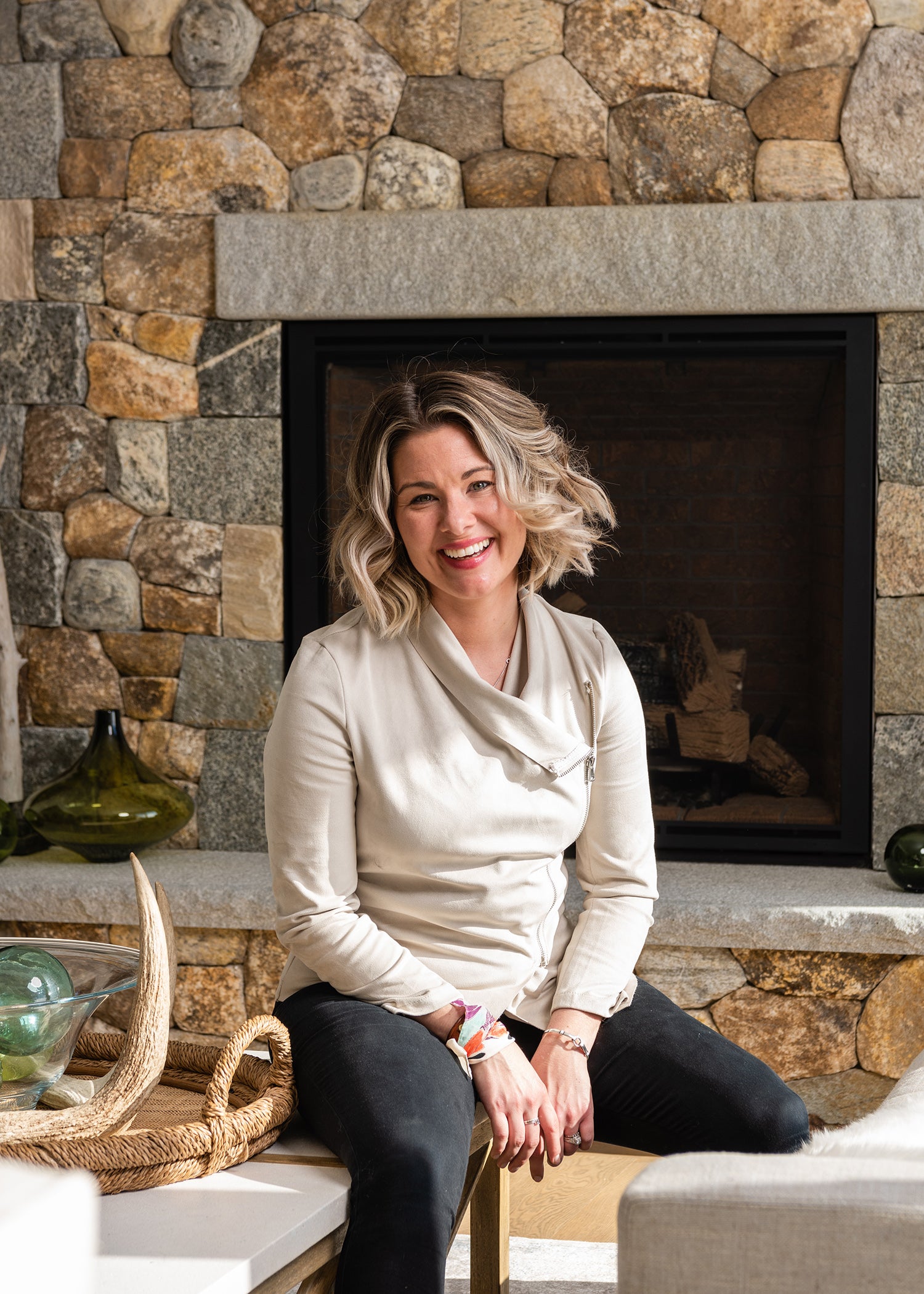The 50 States Project is a yearlong series of candid conversations with interior designers across the country about how they’ve built their businesses. This week, New London, New Hampshire–based Amanda Raymond of Studio Sage tells us how she got over imposter syndrome, became super selective about whom she works with and learned not to take herself too seriously.
What were some of the early influences that drew you to design?
I spent a lot of time with my paternal grandmother, whose house was filled to the brim with antiques. She had amazing costume jewelry, and her dining room had deep crimson wallpaper with dragons on it. We would spend days together traveling from one side of Cape Cod to the other, hunting for treasures—most of which are actually in my house today. That was the birth of things, but even as I approached design school, I wasn’t sure what I wanted to be when I grew up. I did always know that whatever it was, it was going to be in a creative field.
Were there other interests pulling at you as a potential career path?
No, I just did the things that we were supposed to do. We declare a major at, what, 17 years old? I look back now and think, Oh, my gosh, I was such a baby. I wasn’t sold on the idea that I wanted to be a designer at that time—I don’t even think I knew what it meant. As I started to learn more about design, I knew that I wanted to be creating something. It’s interesting, because in interior design, that’s actually only a small piece of the whole thing. Then I started to learn a little bit more of building codes, technical drawings and CAD, which piqued my interest in a different way. At that point, I was really sold—but that wasn’t until my second or third year of design school!
After graduation, what was your first move?
I graduated in 2007 and shortly after, it was the recession of 2008, so I had to be very flexible. There I was with this degree in a luxury business, and not a lot of people were hiring designers. I came back to New Hampshire and worked for a designer in my hometown for just shy of a year—and then, of course, as the most recently hired employee, I was the first to be let go. I ended up picking up and moving to Portland, Maine, where I got a design-build construction job. I moved there within five days of getting the job offer, and I ended up staying there doing design-build construction for four years. Then I reconnected with a former classmate of mine, who’s now my husband, and I moved back to New Hampshire and worked for an architect.
While I was there, I connected with a designer, Sage Scott. She was nearing retirement age. In 2017, two months after my first maternity leave, I purchased her business and took off on the quest to make it my own.
What did that look like?
I worked on rebranding the original business, which was Sage’s Interiors—now it’s Studio Sage. What we do now, and what Sage did, is primarily residential interior design for a second-home market. We’re close to the Lakes Region in New Hampshire, so we do a lot of high-end vacation homes.

What were the advantages of establishing your business that way?
I shadowed Sage during the first year, learned how she ran her business, and identified how I wanted to do things differently. Then it was a smooth transition of her out and me in. She had been in business for about 30 years, so what I purchased was 30 years of client files and relationships. I decided to keep some portion of the name because there was some brand identity here, which is obviously advantageous.
Would you do it again the same way?
I really think I would. One of the great things is that I have clients who call up for Sage and say, “Sage did this for me a while back, and I want to do it again,” or “I want to purchase more of what I already have.” Those 30 years of business suddenly became mine. But there were certain things that were difficult, too, in terms of thinking outside of what had already been done. In reality, I’m great creatively, and I am working really hard on the business side. In retrospect, I might have done things differently there. I think sometimes the established business practice clouds my ability to go a different direction.
In terms of client expectations and having to work in a way that they’re used to?
That’s what’s interesting: We actually work completely differently than Sage did. She didn’t always charge for design time; she didn’t have contracts. To be honest, I think it’s a little bit of a generational thing. Thirty years ago, there wasn’t the complexity of the internet and all of the advertised pricing out there. At that time, you were able to just name your price on goods—there was no Wayfair or Perigold where clients could do that price comparison. Now, you’re really competing with everybody on the internet and all the other vendors selling the same trade products. She would only charge for product, and make her margins through the markup.
Today, we have a flat fee for our design services. We have a contract—a contract that changes on the regular as we learn what it’s missing. And what that does is more clearly outline the expectations.
I think a contract is probably always a good idea. But for you, what did it change?
One of the things that we experienced regularly was scope creep. All of a sudden, it’s not two sofas, it’s three—oh, and we threw a bathroom in there, too. Now, everything has a contract and an outlined scope that’s agreed upon at the beginning of the project, just to keep everybody’s expectations aligned. More than anything, it’s such a big thing to protect our relationship with our clients. That way, they know that I’m not saying, “I’m not doing this” because I don’t want to or you’re not paying me enough, because that sounds insulting. What we need to do is generate a new contract [to accommodate the additional work]. It’s a better way of saying the same thing.
Sage’s background was more interior decorating, but I wanted to do whole house projects. I have a background in design-build construction and architecture, so my approach is a little bit more technical. But for a long time, I was getting clients wanting to pick out fabrics for throw pillows or draperies. It was basically a practice in politely educating the client base that I had just purchased the company, and that I was so grateful for their business, but that things are looking a little bit different now.
Is everyone on board at this point?
I want to say everybody’s super happy and everybody loves me and everything’s great, but no. I think, honestly, it’s been a little off-putting for some people. For example, we sell Hunter Douglas products. But Sage actually used to restring shades, which was part of the services she offered. I don’t do that, so one of my biggest growing pains, believe it or not, is the fact that I have to tell clients, “I’m sorry, we no longer do that. You need to call somebody else.” That’s been a really stressful thing for clients. I think the people who get it, get it, and people who don’t, don’t—which sounds so obvious, but I think that’s the best way that I can answer it.

What does your team look like right now?
My first hire was Bree Sowle, who is an associate designer. She came to our firm in the summer of 2018 as an intern and I never let her go. Around the same time, I started collaborating with Candita Clayton, who is now our in-house art curator, and we now have a contemporary art gallery as part of our business. Then, in the last 12 months, Liz Hause, who managed her own very successful interior design practice in the area for about 15 years, joined our team as our senior designer.
We have about 15 projects in our queue, which vary in scale. We have the refreshes—the clients that have the living room in golds, hunter greens and cranberry, and are looking for something different now. We also have three new constructions that are between 3,000 and 7,000 square feet. We get involved at the start of the process, establishing a relationship with the client, architect and contractor, and we work from the selection process—the plumbing fixtures, the tile, the profile of the interior trim, any sort of paneling—and go through the furnishings process with them.
For a client who wants to refresh, is that a new fabric for their hunter green plaid sofa or is that a replacement sofa?
It comes down to managing client expectations. We do a good amount of re-upholstery, but some clients are really surprised to find out that re-upholstery is actually not much less expensive than purchasing new. It comes down to, Is this piece special? Is it well-made? Does it mean something to you?
How do new clients find you these days?
The biggest thing for us is word-of-mouth, whether it’s from past clients or people I know. I’ve been living in the area since I was 12 years old, so there’s the fact that I’m a local gal—whether or not it’s somebody who’s worked with me, it’s somebody who knows me.
Where do you shop?
In our area, there aren’t a lot of showrooms. It is a challenge that we’ve learned to work around, but it’s definitely a real challenge for our clients. If they were to go shop somewhere, it’s difficult—we use samples from manufacturers, our in-house library, and then if they want to sit on pieces of furniture, we hit up the Boston Design Center for stuff like that. It’s a two-hour drive for us, but a lot of our clients are out of Boston, so it’s convenient for them.

How do you decide what you say yes to right now?
I love how you said “right now,” because that’s actually a huge thing. There was a time not too long ago when I said yes to every single thing—everything. Now, I do feel like I can say no and really assess the project based on a couple of things. One is the scope of work, and where we are at with our current workload—are we looking for a small project that’s more of a filler, or are we ready to take on that next 7,000-square-foot house? And then I’m looking at the profitability, too. Once that 7,000-square-foot house slot is full, it’s full for the year, so I want to make sure it’s something that can help us to sustain the business and sustain our clients, because that’s super important.
I am a little bit selective about who we work with. I realized early on in the business which architects and builders I wanted to work with and how I wanted to elevate my business to complement theirs. So we really want to align ourselves with contractors and architects and subcontractors that have the same attention to detail, that have the same personal philosophies that we do, that have a great track record, because then we all win. There have been a couple of times where the entire boat sinks and we all go down with it. That only needs to happen a couple of times.
The other thing is the clients. Those initial meetings are just as much for us as for them—which feels weird to say, because the thought process has been “The customer’s always right,” which is not true. When we sit down for that initial interview, I’m never asking anyone to sign on the spot, because I want them to digest this and see if we’re the right fit. At the end of the day, the process is really long, and we are going to spend a lot of time together, and I think it has to work both ways. Thankfully, after meeting a client, I’ve never had to go, “No, thanks.” I hope I never have to do that, but I think it’s an important thing—not to be ignored on both ends of the spectrum.
What are you looking for in that initial phone call so that you know you want to meet?
We talk about how we work, and if there’s resistance to the contract, that’s a huge red flag. It does need to fit our calendar, and we do have a certain expectation of how we’re compensated. It’s only fair to show those cards upfront, because everybody’s time is super valuable.
I sometimes still have imposter syndrome where I’m saying these things, but in my head I’m going, “Oh, I could really do this job for no consulting fee” because it’s a great portfolio builder. But for the most part, there are things that we need as a business and that I need as a business owner, and it’s taken me a good amount of time to recognize those and know that my business practices are not open for negotiation. It’s not up to the client to change my business model, because I created it for a reason.
Luckily for me, there are three people in my office who will remind me that those things are nonnegotiable: “You made this business practice. Why are we bending it for them?” And that’s an important question—why? This a portfolio builder? A client that’s well-connected? All of those factors play into [the decision]. I think there has to be a gut feeling, and as I’m getting older, I’m starting to listen to that a little bit more.
What is the biggest thing you wish you had known from the start?
I wish I knew to value the time. Some of the most valuable things that we as a design collaborative can offer our clients are our time and our expertise. As a
young professional, [I’m] putting a dollar amount on it and asking you, a person that I barely know, to take a chance and believe that I am worth this amount. I think it’s absolutely critical.

Where do you see the biggest opportunity to grow as you look ahead?
I think it’s in the relationships that we form with other professionals. Right now, I’ve got three projects or so that are with the same contractor and architect, which is funny. So it’s almost like the same cast of characters on every job. It’s the way that you work with each other, the way that you realize somebody else’s skill set, where they probably need your help, where you need their help. The ability to be able to just get into a routine with a certain group has been huge for us. Instead of re-creating the wheel with every job, I think it’s just learning how you fit into the project.
Can you tell me a little bit about the art curation piece of the business?
We really love being able to include pieces that are specific to each project—something that sets our work apart from the other designers in the area. One way we do that is to have eyes on the art early on in the design process—something that the neighbor down the street doesn’t have, because we’re living and working in an industry of so many mass-produced items. If Serena & Lily are ever going to read this interview, I say this with the utmost respect, but you can go door to door and see the same Serena & Lily pillows and things like that, and all of a sudden, it just doesn’t feel special.
I think what people want when they come to a designer, and the reason why they’re not doing these things themselves, is because they want something special. They want something unique to them, and the way we’re able to do that is to offer one-of-a-kind keystones in each project. So, what we started doing, after Candida and I began collaborating in 2018, was to provide white-glove art services to our clients. That meant we would survey the space, listen to our clients, and then start to pitch some art pieces—physically bring them over and see them in the space. We had some huge success with that in the early years, and a real estate opportunity became available. So we decided to take the leap and provide our clients with an actual brick-and-mortar contemporary art gallery to visit.
When you break down your books, is that a significant part of your business?
I wouldn’t say so from a financial standpoint, but as far as leveling up my designs, it’s been significant. If you look at any project after incorporating these substantially special pieces, it’s really leveled up our design game more significantly than probably the profitability.

How do you approach your office culture?
My goal for our brand identity has been that we take our business super seriously. We take the profound responsibility of helping our clients create their home with the utmost responsibility, but at the end of the day, we don’t take ourselves too seriously.
I was nominated for New England Home’s “5 Under 40” list. I ended up not getting it, but I still use the [info we sent them] as our collateral material. It’s so cute because we had our headshots and a group photo done, with us laughing and Liz, our senior designer, giving us bunny ears. At the end of the day, it’s not the most professional image and we all kind of laugh at it. But for me, it’s really important for our clients to understand that while we take our job really seriously, we’re not serious people and we really enjoy what we do.
What does success look like for you?
Success is to get up every morning, feel really good about what we’re doing, build relationships with people and help them make their house their own. It sounds super cliched, but every day I get the great fortune of being able to do this work and meet amazing people, and most often, they leave really liking us and I consider them to be friends, which is an amazing gift. If I’m able to make my mortgage [while doing that], I’m thumbs all the way up.
To learn more about Amanda Raymond, visit her website or find her on Instagram.
Homepage photo: Amanda Raymond | Courtesy of Studio Sage





























